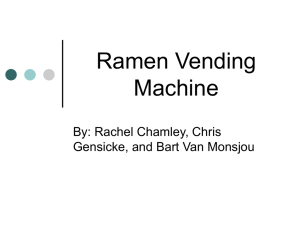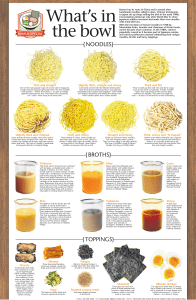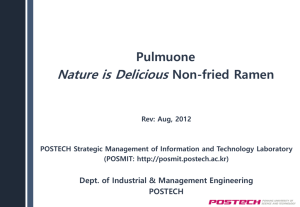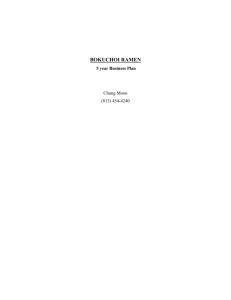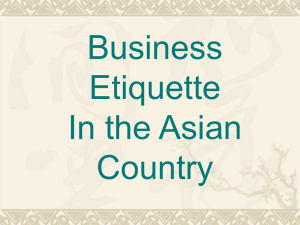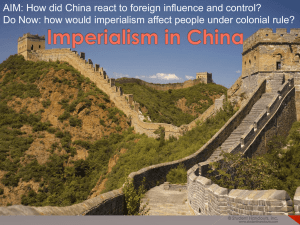Experiencing Multiplicity: food and identity
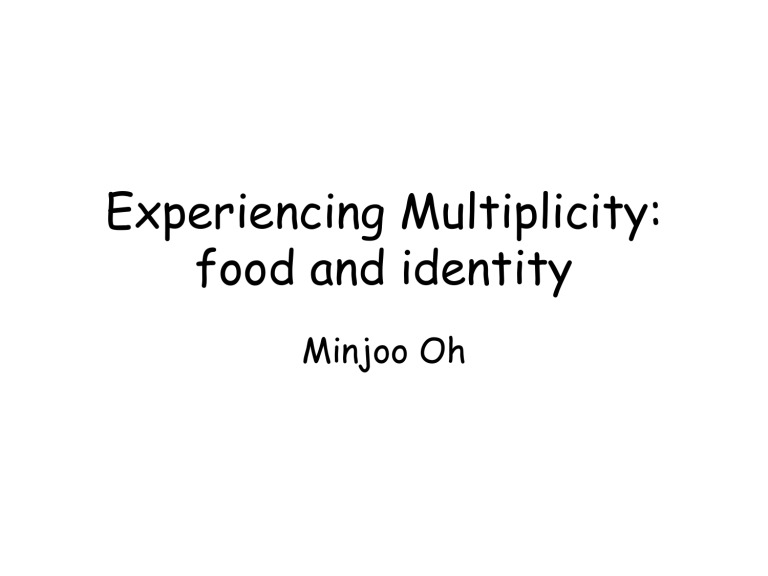
Experiencing Multiplicity: food and identity
Minjoo Oh
“Tell me what you eat, I will tell you who you are.”
• Can you tell who I am if I tell you what I eat?
• Body
• Home
• Community
• City
• Region
• National
• Global
• French wine and Turkish coffee houses represent suitable cultural metaphors for learning how to do business with those countries.
• Drinking Guinness is a strong connotation of Irishness.
• Rice as the staple of Japanese diet has a special centrality in national identity formation [Rice as Self
(1993) by Emiko Ohnuki-Tierney]
• What items constitute the Japanese diet?
• What is archetypal American food?
• American a)homogeneous, processed, massproduced food b)The multi-ethnic mixtures of particular regions
Jennifer Lee hunts for
General Tao
• http://www.ted.com/talks/lang/eng/jennifer_8_lee_looks_f or_general_tso.html
• The longer we ponder questions like these, the more difficult they become to answer.
• National cuisines are in a process of constant reinvention, absorbing new influences and letting some traditions die out.
• Nevertheless, a nation’s diet can have a key role to play in nationalistic sentiments, with threatened invasions of “filthy foreign food” being seen as dangerous to the whole fabric of national identity.
• At the same time, national cuisines are often celebrated for their exotic difference.
• Sometimes a nation’s identity is captured by a single food item.
• For instance, curry is synonymous with India. In other cases, it is the manner of cooking as much as the ingredients and final dishes with define a national cuisine.
• Food and the nation are so commingled in popular discourses that it is often difficult not to think one through the other.
• “To imagine a Japan without ramen almost borders on heresy.”
• “Ramen is so Japanese.” from Barak Kushner’s interview
How to eat ramen
• http://www.youtube.com/watch?v=6WrkdTrrwew
• Like a language, food articulates notion of inclusion and exclusion, of national pride and xenophobia, on our tables and in our lunchboxes.
• The history of any nation’s diet is the history of the nation itself, with food fashions, fads and fancies mapping episodes of colonialism and migration, trade and exploration, cultural exchange and boundary-making.
• And yet here begins one of the fundamental contradictions of the food-nationalism equation: there is no essential national food.
• The food which we think of as characterizing a particular place always tells stories of movement and mixing.
• What appear to be indigenous foodways may actually be cultural imports, like the café, whose French cultural identity is relatively recent, having been imported in the seventeenth century.
Ramen
• Ramen entered the Japanese market as an inexpensive, accessible, lowclass food for itinerant peddlers and poor students in the early twentieth century.
• The number of chinese students living in Japan was significant, one of the largest foreign groups by far.
• From 1896 to just before 1938, approximately fifty thousand Chinese students in some form or other studied in Japan, greatly influencing lower and middle class restaurant offerings in most urban areas.
• Chinese emigrated to Japan to work.
However, after losing to Japan in the
Sino-Japanese War in 1895, they came in increasing numbers to study how Japan modernized so quickly and surpassed China.
• Students as well as laborers flocked to the new communities in Yokohama, parts of Tokyo, Kyushu, Kobe, and
Sapporo in the north.
• Ramen tells an historical story different from our stereotyped assumptions of Japanese cuisine and its interaction with foreign communities .
• The Japanese of the early Taisho era
(1912-26) considered Chinese cuisine backward. Not until after World War
Two did Chinese cuisine gain recognition as something worthy.
Instant ramen
• Instant ramen were created in 1958 by Japan’s Nissin Foods.
• Momofuki Ando, who died in Ikeda, near Osaka at 96, was looking for cheap, decent food for the working class when he invented ramen noodles in 1958. His product – fried, dried and sold in little plastic wrapped bricks or foam cups – turned the company he founded, Nissin Foods, into a global giant.
• Ironically, Japan’s food industry initially rejected the product as a novelty with no future.
• Instant ramen representing “Made in
Japan,” are now not only a national food but a global food.
• Now sells more than 65 billion bowls every year (as of 2008)
• “more people around the world eat ramen in some form on a daily basis than any other foodstuff.”
• In 2000, the Fuji Research Institute had survey of what the Japanese see as their best exports and their best invention of the 20 th century.
1) Instant ramen
2)Karaoke
3)Walkman
4)Nintendo
5)Compact discs
6)Compact cameras
7)Akira Kurosawa
8)Pokemon
• Okuyama Tadamasa claims that the proliferation of ramen franchises in
Japan and its spread from the Far
East into the rest of the world demonstrate the end of western dominance over national cuisines.
• Taiwan, according to statistics from the International Ramen
Manufacturers Association, is the world’s 12 th largest instant noodle market, worth an annual US$300 million. This translates into an annual total of 900 million packs, or 40 per person. (2007)
• South Koreans consume the greatest amount of instant noodles, 69 per capita per year.
Economic indicator
• In Thailand, the dominant Mama noodles brad has spawned the “Mama
Noodles index,” which accurately forecast a weakening of the economy in 2005.
• The 2 million inmates in U.S. prisons would be responsible for about 10% of the nation’s 4.2 billion instantnoodles sales (November 4 th 2008,
MSN)
• What inmates once priced in cigarettes they now trade for noodles.
• College students
Popularity of ramen
• The end of Western dominance?
• “Clash of civilization” ?
• or, constant symbiotic synthesis?
• Okuyama’s thesis posits a happy and peaceful co-existence of cultures leading to tasty treats in the next century in contrast to the more pessimistic view of Huntington.
Claude Levi-Strauss
Food is not only good to eat, but also good to think with.
Mary Douglas
If food is treated as a code, the messages it encodes will be found in the pattern of social relations being expressed. The message is about different degrees of hierarchy, inclusion and exclusion, boundaries and transactions across the boundaries.
Metamorphoses of ramen
1. Immigrant food
2. Urban laborer
3. An antidote for postwar starvation
4. New taste of convenience and speed
5. Elite dish (not-instant, traditional kind has become hip)
Glocalization
A term that was invented in order to emphasize that the globalization of a product is more likely to succeed when the product or service is adapted specifically to each locality or culture it is marketed in. The term combines the word globalization with
localization.
Fast Food
• McDonald
• Ekiban
• Yumcha
• Thai street food
Fast Food Nation: The Dark Side of the
All-American Meal
Pull open the glass door, feel the rush of cool air, walk in, get on line, study the backlit color photographs above the counter, place your order, hand over a few dollars, watch teenagers in uniforms pushing various buttons, and moments later take hold of a plastic tray full of food wrapped in colored paper and cardboard.
The whole experience of buying fast food has become so routine, so thoroughly unexceptional and mundane, that it is now taken for granted, like brushing your teeth or stopping for a red light. It has become a social custom as American as a small, rectangular, hand-held, frozen, and reheated apple pie. (Eric
Schlosser, 2001: 4)
Savor Slowly: ‘Ekiben’
The Fast Food of High Speed Japan
Ekiben: railroad station box-lunches
These lunches consists of small boxes containing a variety of food items, all part of traditional Japanese cuisine, sold in railroad stations and trains all over the country.
Yumcha
• Yumcha as a form of food consumption can best be understood in contrast to a meal. A meal is considered to be proper, official, elaborate; it involves a fixed schedule with dishes served according to an established program, and it always includes a staple such as rice.
• Yumcha is considered to be casual and unofficial, and staples are not necessarily involved. Whereas meals are served by someone such as a waiter, yumcha involves more ‘selfhelp’ behavior.
Not From Scratch:
Thai Food Systems and Public Eating
Women can be seen stopping at a food shop in the evenings on their way home from work to pick up dinner for the family, main courses are placed in small plastic bags with rice being prepared easily at home in a rice cooker... For typically middle-class
Bangkokians – particularly women who tend to be impeccably dressed – frequently cool, comfortable establishments is the most desirable option. The urban masses are, for the most part, of humble economic means and purchase food on the streets and from vendors both mobile and stationary, and small food-shops specializing in noodles, curried dishes or other fare.
If our identities became homeless, exile, migrant, nomadic, displaced, and permanent stranger-like, how can we talk about the connection between what we eat and who we are?
We conceive of our age as existing beyond the normal frames of time and space.
Time flies, and yet each instant is crammed with things to do. Time-saving devices create more time but also require us to save more of it. Vast distances are crossed in no time at all, and yet we seem to spend all of our time either going from place to place or watching the world go by.
There is no time to do nothing and no place to do it because doing nothing seems too much like doing something else. (Siebers,
1994: 1)
